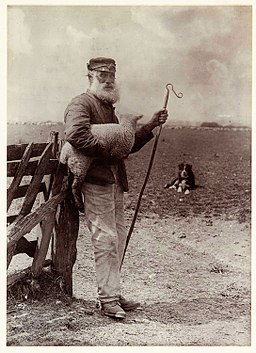Have the Chops

A British shepherd with a lamb and his Border Collie in the 1890s. Photo from the National Media Museum of the United Kingdom.
American sheep herding declined to a cottage industry, which had the ironic effect of insulating it further from the factory farming practices which had taken over other areas of animal husbandry by the end of the twentieth century. The mutton and lamb available in Middle American supermarkets in the same period was likely as not imported from Australia or New Zealand. The imported meat was cheaper than American raised mutton and lamb despite the long shipping distances because of the economies of scale in those countries, where sheep were still raised in the tens of millions. Americans generally did not favor the imported meat over beef, chicken, and pork, however, because of the “gaminess” they noted in it, a product of the types of sheep raised in Australia and New Zealand and the pasture they were raised on. Americans had gotten so used to the blandness of meat produced by grain diets for factory farmed animals that they started rejecting anything stronger.
From The George Burns and Gracie Allen Show of the 1950s, the two performers reenact one of their vaudeville routines for announcer Harry Von Zell.
As Americans begin to reject factory farming out of both the inhumane nature of it and the unhealthy food it produces, prospects for sheep herders in this country are improving. Considering the practices most, but certainly not all, of them have adhered to over the last half century through some bad times, it’s not that they ever went anywhere, but that the rest of us did and are now drifting back to them in dribs and drabs. If it weren’t for the support of the immigrant population and their preference for American lamb and mutton, the sheep herders here would not likely have survived the lean times in sufficient numbers to crank up operations again with the promise of supplying more Easter dinners. Of the lambs the best that can be said is that unlike many of their unfortunate cousins on the factory farms their lives, however brief, may be more natural and even peaceful.
— Vita 
